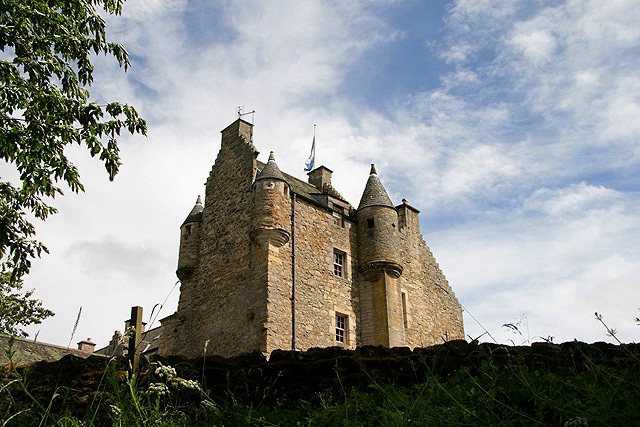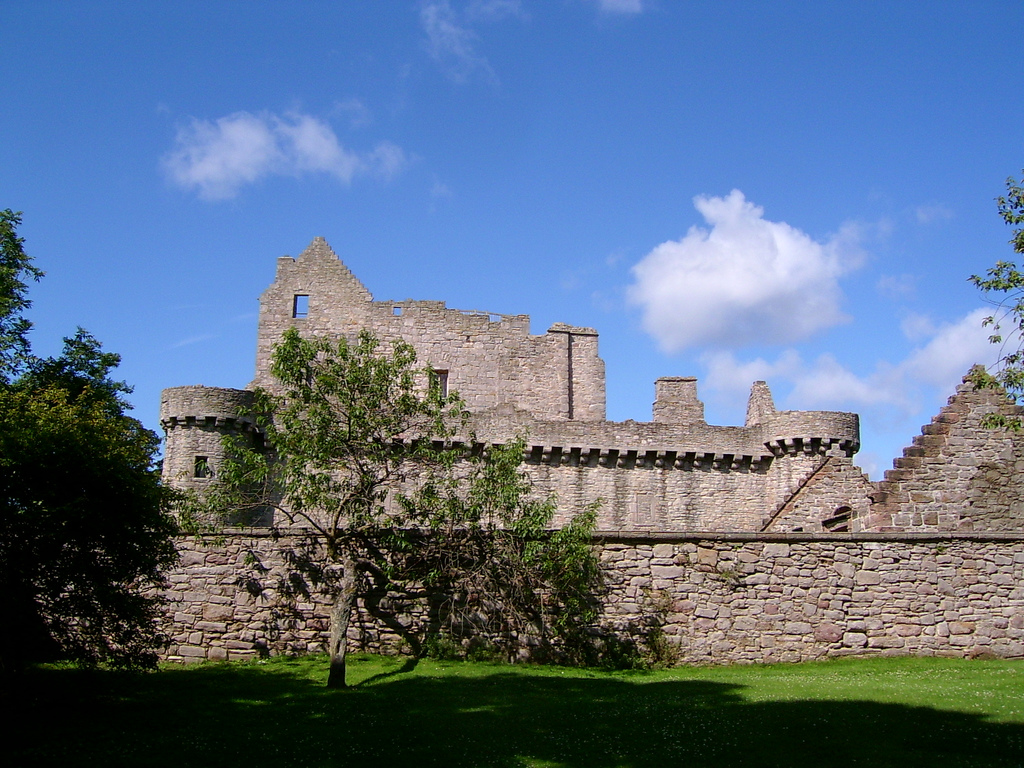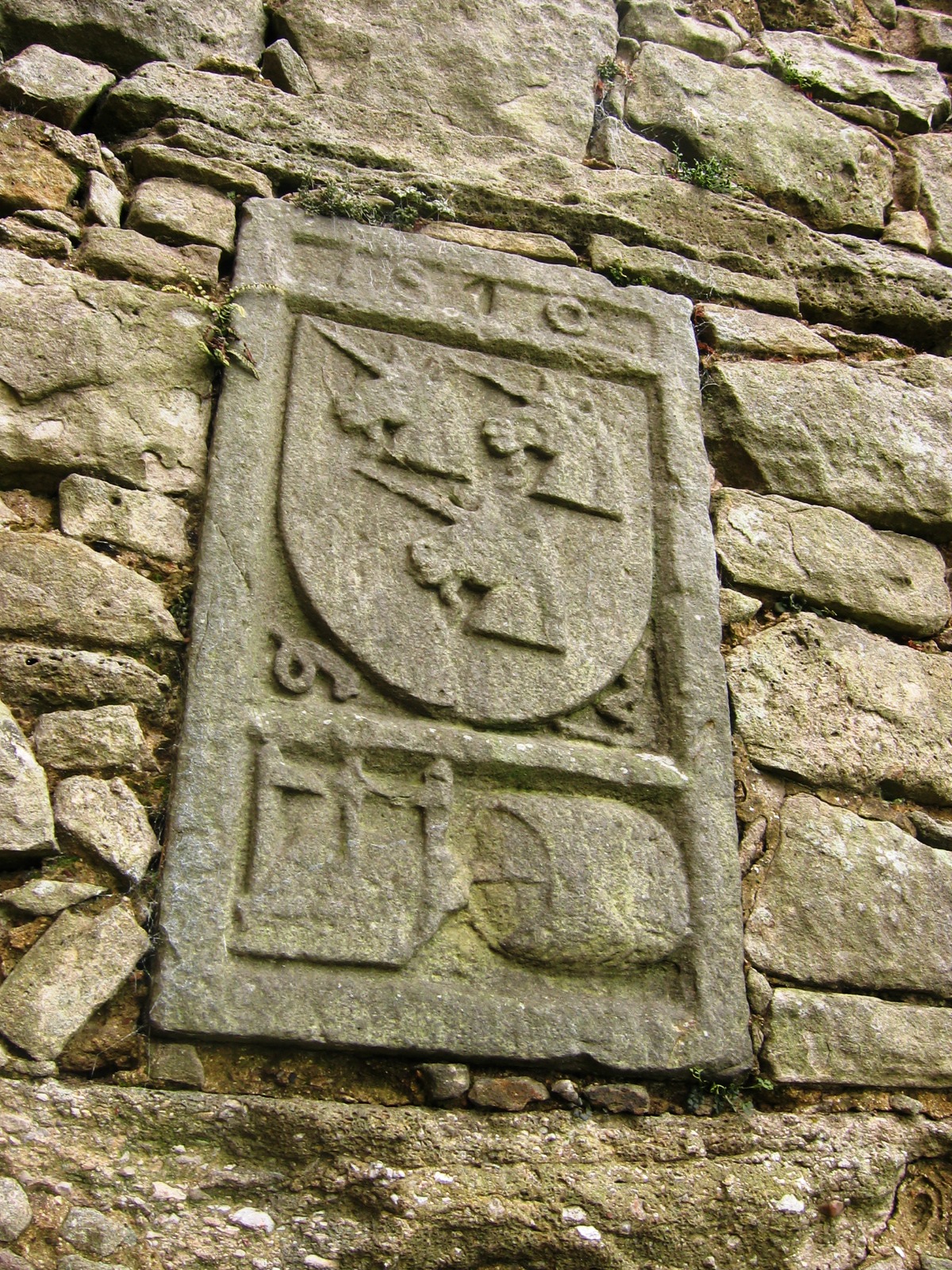|
Janet Beaton
Janet Beaton, Lady of Branxholme and Buccleugh (1519–1569) was an aristocratic Scottish woman and a mistress of James Hepburn, Earl of Bothwell. She had a total of five husbands. One of her nieces was Mary Beaton, one of the four ladies-in-waiting of Mary, Queen of Scots, known in history as the four Marys. In her lifetime, she was accused of having been a witch. Janet was immortalised as Sir Walter Scott's ''Wizard Lady of Branxholm'' in his celebrated narrative poem "Lay of the Last Minstrel". Family Janet was born in 1519, one of the eleven children of Sir John Beaton, 2nd Laird of Creich and Janet Hay, daughter of John Hay, provost of Dundee by his wife Elizabeth Crichton. Her father was the hereditary keeper of Falkland Palace. Her brother was Robert Beaton, 4th Laird of Creich, and her sister, Elizabeth Beaton was a mistress of King James V of Scotland, by whom she had an illegitimate daughter, Jean Stewart. Her niece was Mary Beaton, one of the celebrated ladies-in ... [...More Info...] [...Related Items...] OR: [Wikipedia] [Google] [Baidu] |
Scotland
Scotland (, ) is a country that is part of the United Kingdom. Covering the northern third of the island of Great Britain, mainland Scotland has a border with England to the southeast and is otherwise surrounded by the Atlantic Ocean to the north and west, the North Sea to the northeast and east, and the Irish Sea to the south. It also contains more than 790 islands, principally in the archipelagos of the Hebrides and the Northern Isles. Most of the population, including the capital Edinburgh, is concentrated in the Central Belt—the plain between the Scottish Highlands and the Southern Uplands—in the Scottish Lowlands. Scotland is divided into 32 administrative subdivisions or local authorities, known as council areas. Glasgow City is the largest council area in terms of population, with Highland being the largest in terms of area. Limited self-governing power, covering matters such as education, social services and roads and transportation, is devolved from the Scott ... [...More Info...] [...Related Items...] OR: [Wikipedia] [Google] [Baidu] |
James V Of Scotland
James V (10 April 1512 – 14 December 1542) was List of Scottish monarchs, King of Scotland from 9 September 1513 until his death in 1542. He was crowned on 21 September 1513 at the age of seventeen months. James was the son of James IV of Scotland, King James IV and Margaret Tudor, and during his childhood Kingdom of Scotland, Scotland was governed by regents, firstly by his mother until she remarried, and then by his second cousin, John Stewart, Duke of Albany, John, Duke of Albany. James's personal rule began in 1528 when he finally escaped the custody of his stepfather, Archibald Douglas, 6th Earl of Angus, Archibald Douglas, Earl of Angus. His first action was to exile Angus and confiscate the lands of the Clan Douglas, Douglases. James greatly increased his income by tightening control over royal estates and from the profits of justice, customs and feudal rights. He founded the College of Justice in 1532, and also acted to end lawlessness and rebellion in the Anglo-Scotti ... [...More Info...] [...Related Items...] OR: [Wikipedia] [Google] [Baidu] |
Clan Kerr
Clan Kerr () is a Scottish clan whose origins lie in the Scottish Borders. During the Middle Ages, it was one of the prominent border reiver clans along the present-day Anglo-Scottish border and played an important role in the history of the Border country of Scotland. History Origins of the clan The name Kerr is rendered in various forms such as Kerr, Ker, Kear, Carr, Carre, and Cares.Lower, Mark A (1860) Patronymica Britannica: a dictionary of the family names of the United Kingdom. London: J.R. Smith. Public Domain. p. 52. The name stems from the Old Norse ' which means ''marsh dweller'', and came to Scotland from Normandy, the French settlement of the Norsemen. Another variant is found on the west coast of Scotland, particularly on the Isle of Arran, taken from the Gaelic ', meaning ''dusky''. The early Roxburghshire Kerrs had their origins in the 12th century Ayrshire bailiery of Cunninghame. During the reign of David I (1082–1153), Hugh de Morville, Lord High Constabl ... [...More Info...] [...Related Items...] OR: [Wikipedia] [Google] [Baidu] |
Royal Mile
The Royal Mile () is a succession of streets forming the main thoroughfare of the Old Town of the city of Edinburgh in Scotland. The term was first used descriptively in W. M. Gilbert's ''Edinburgh in the Nineteenth Century'' (1901), describing the city "with its Castle and Palace and the royal mile between", and was further popularised as the title of a guidebook by R. T. Skinner published in 1920, "''The Royal Mile (Edinburgh) Castle to Holyrood(house)''". The Royal Mile runs between two significant locations in the royal history of Scotland: Edinburgh Castle and Holyrood Palace. The name derives from it being the traditional processional route of monarchs, with a total length of approximately one Scots mile, a now obsolete measurement measuring 1.81km. The streets which make up the Royal Mile are (west to east) Castlehill, the Lawnmarket, the High Street, the Canongate and Abbey Strand. The Royal Mile is the busiest tourist street in the Old Town, rivalled only ... [...More Info...] [...Related Items...] OR: [Wikipedia] [Google] [Baidu] |
Liddesdale
Liddesdale, the valley of the Liddel Water, in the Roxburghshire, County of Roxburgh, southern Scotland, extends in a south-westerly direction from the vicinity of Peel Fell to the River Esk, Dumfries and Galloway, River Esk, a distance of . The Waverley Line, Waverley route of the North British Railway runs down the dale, and the Catrail, or Picts' Dyke, crosses its head. Liddesdale was also a historic district of Scotland, bordering Teviotdale to the east, Annandale, Dumfries and Galloway, Annandale to the west and Tweeddale to the north, with the England, English county of Cumberland across the border to the south. The area was in the Sheriffdom of Roxburgh and later became part of the Roxburghshire, County of Roxburgh, one of the counties of Scotland. The main reorganisation took place during the Local Government (Scotland) Act 1889, this Act established a uniform system of county councils and town councils in Scotland and restructured many of Scotland's counties. (See: Histor ... [...More Info...] [...Related Items...] OR: [Wikipedia] [Google] [Baidu] |
Border Reivers
Border reivers were Cattle raiding, raiders along the Anglo-Scottish border from the late 13th century to the beginning of the 17th century. They included both Scotland, Scottish and England, English people, and they raided the entire border country without regard to their victims' nationality. Their heyday was in the last hundred years of their existence, during the time of the House of Stuart in the Kingdom of Scotland and the House of Tudor in the Kingdom of England. Background Scotland and England were frequently at war during the late Middle Ages. During these wars, the livelihood of the people on the Borders was devastated by the contending armies. Even when the countries were not formally at war, tension remained high, and royal authority in either or both kingdoms was often weak, particularly in remote locations. The difficulty and uncertainties of basic human survival meant that communities and/or people kindred to each other would seek security through group streng ... [...More Info...] [...Related Items...] OR: [Wikipedia] [Google] [Baidu] |
William Borthwick, 6th Lord Borthwick
William Borthwick, 6th Lord Borthwick (died 1582) was a Scottish landowner. William Borthwick was the son of John, 5th Lord Borthwick and Isobel Lindsay, daughter of David Lindsay, 8th Earl of Crawford. Borthwick first attended the Privy Council of Scotland on 22 August 1567, when the act of abdication of Mary, Queen of Scots was read out by Lord Lindsay and James, Earl of Moray was appointed Regent of Scotland. Marriage and separation He married Grissel Scott, daughter of Walter Scott of Branxholme and Buccleuch and Janet Beaton In 1578 his wife Grissel Scott tried to obtain a divorce. She complained that Borthwick's behaviour was instigated by Satan, that he insulted her and hurt her physically, even when pregnant. She had lived apart from him in Edinburgh for a year and a half. The Privy Council of Scotland ordered Borthwick to pay her thirty shillings each day during the court process. In September the council judged them reconciled. Borthwick agreed he would not receive ... [...More Info...] [...Related Items...] OR: [Wikipedia] [Google] [Baidu] |
William Fraser (historian)
Sir William N. Fraser, (18 February 1816 – 13 March 1898) was a solicitor and notable expert in ancient Scottish history, palaeography, and genealogy. Life Fraser's family came of the stock of farmers and craftsmen in The Mearns. He was born the eldest of two sons and a daughter of James Fraser (1786 – 1834), a mason, and his spouse Ann (died 1821), daughter of James Walker, tenant of the farm of Elfhill of Fetteresso, about 5 miles from Stonehaven. The couple were settled and were feuholders at Links of Arduthie. William Fraser was initially educated at a private school in Stonehaven kept by the Reverend Charles Michie, a M.A. graduate of Aberdeen's Marischal College in 1810, who spent his life teaching. On 23 August 1830, Fraser began a five-year apprenticeship with Messrs., Brand and Burnett, solicitors in Stonehaven. He went to Edinburgh in December 1835, where he joined the firm of Hill and Tod, Writers to Her Majesty's Signet. He continued his education at Edi ... [...More Info...] [...Related Items...] OR: [Wikipedia] [Google] [Baidu] |
Clan Scott
Clan Scott is a Scottish clan and is recognised as such by the Lord Lyon King of Arms.Way, George and Squire, Romily. ''Collins Scottish Clan & Family Encyclopedia''. (Foreword by The Rt Hon. The Earl of Elgin KT, Convenor, The Standing Council of Scottish Chiefs). Published in 1994. pp. 314–315. Historically the clan was based in the Scottish Borders. History Origins The Latin word ''Scotti'' was originally used to describe the Celts of Ireland. However the historian George Fraser Black notes in his ''Surnames of Scotland'' that the earliest certain record of the name was that of Uchtred 'Filius Scott', in a charter from around 1120. In 1195 Henricus le Scotte witnessed a charter by David, Earl of Strathearn. At the beginning of the thirteenth century a Master Isaac Scotus witnessed charters by the Bishop of St Andrews. Michael Scott "The Wizard" (1175 – c.1232) was a real-life scholar and philosopher, whom Walter Scott described in ''The Lay of the Last Minstrel'' as ... [...More Info...] [...Related Items...] OR: [Wikipedia] [Google] [Baidu] |
Consanguinity
Consanguinity ("blood relation", from Latin '' consanguinitas'') is the characteristic of having a kinship with another person (being descended from a common ancestor). Many jurisdictions have laws prohibiting people who are related by blood from marrying or having sexual relations with each other. The degree of consanguinity that gives rise to this prohibition varies from place to place. Such rules are also used to determine heirs of an estate according to statutes that govern intestate succession, which also vary from jurisdiction to jurisdiction. In some places and time periods, cousin marriage is allowed or even encouraged; in others, it is taboo, and considered to be incest. The degree of relative consanguinity can be illustrated with a ''consanguinity table'' in which each level of lineal consanguinity (''generation'' or ''meiosis'') appears as a row, and individuals with a collaterally consanguineous relationship share the same row. The Knot System is a numerical notati ... [...More Info...] [...Related Items...] OR: [Wikipedia] [Google] [Baidu] |
Craigmillar Castle
Craigmillar Castle is a ruined medieval castle in Edinburgh, Scotland. It is south-east of the city centre, on a low hill to the south of the modern suburb of Craigmillar. The Preston family of Craigmillar, the local feudal barons, began building the castle in the late 14th century and building works continued through the 15th and 16th centuries. In 1660, the castle was sold to Sir John Gilmour, Lord President of the Court of Session, who breathed new life into the ageing castle. The Gilmours left Craigmillar in the 18th century for a more modern residence, nearby Inch House, and the castle fell into ruin. It is now in the care of Historic Environment Scotland as a scheduled monument, and is open to the public. Craigmillar Castle is best known for its association with Mary, Queen of Scots. Following an illness after the birth of her son, the future James VI, Mary arrived at Craigmillar on 20 November 1566 to convalesce. Before she left on 7 December 1566, a pact known as the ... [...More Info...] [...Related Items...] OR: [Wikipedia] [Google] [Baidu] |
Simon Preston Of Craigmillar
Simon Preston of Craigmillar (c. 1510 – c. 1570) was Lord Provost of Edinburgh during the years 1565 to 1569 and was a member of the Privy Council of Scotland during the reign of Mary, Queen of Scots. Political career Simon Preston was involved in the rebuilding of Holyrood Palace in September 1554 for Mary of Guise, Regent of Scotland. He supplied lead for the roof. The palace had been damaged by an English army in 1544. Tantallon Castle came into the hands of Mary of Guise in February 1557. The Earl of Cassillis appointed Preston as the castle's keeper. In January 1561 Queen Mary sent Simon Preston to Scotland as her envoy. He and his three colleagues were instructed to announce the death of her husband Francis II of France, and her decision to return to Scotland. They came first to Preston's own Craigmillar Castle, and met William Maitland of Lethington. The English diplomat in Edinburgh Thomas Randolph was not very pleased with this news (which did not suit his ... [...More Info...] [...Related Items...] OR: [Wikipedia] [Google] [Baidu] |





.png)

